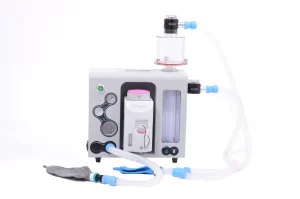Portable anesthesia machines are commonly used devices in the medical field. Compared to traditional large-scale anesthesia machines found in hospitals, portable anesthesia machines offer the advantage of flexibility and portability. However, to ensure patient safety and equipment hygiene, proper disinfection procedures are essential. This article will explore different types of portable anesthesia machines, the differences between them and large-scale hospital machines, and the precautions to be taken during the disinfection process.

Types and Distinctions of Portable Anesthesia Machines
There are several types of portable anesthesia machines, each with its own characteristics and applications. Here are a few common types:
Pneumatic Anesthesia Machines: These machines provide anesthesia using compressed air or oxygen supply. They are typically small, lightweight, and suitable for use in smaller medical settings or temporary medical sites.
Electronic Anesthesia Machines: These machines utilize electricity to administer anesthesia. They offer precise control and adjustment features. Equipped with display screens and adjustable parameters, they are suitable for procedures requiring higher precision.
Spray Anesthesia Machines: This type of machine delivers anesthesia through a spraying mechanism into the patient's respiratory system. They offer quick and efficient anesthesia administration, making them particularly suitable for pediatric surgeries and emergency situations.
Compared to large-scale anesthesia machines found in hospitals, portable anesthesia machines are typically smaller, more portable, and easier to operate. They are well-suited for special scenarios such as emergency care, field hospitals, and remote medical facilities.
Distinctions Among Portable Anesthesia Machines
While portable anesthesia machines share similar functions, there are still some distinctions among them. Here are a few common differentiating factors:
Size and Weight: Different models of portable anesthesia machines may vary in size and weight. These factors directly impact the device's portability and ease of transport.
Functionality and Parameters: Different models of portable anesthesia machines may offer varying functionalities and adjustable parameters. Some devices may provide a wider range of gas flow, more precise drug delivery, and various monitoring capabilities.
Power Supply and Battery Life: Portable anesthesia machines typically require either a power supply or battery operation. Certain devices may come with longer-lasting batteries, allowing for extended use or operation in environments without a power source.
Understanding the distinctions among different models of portable anesthesia machines is crucial in selecting the appropriate device for specific needs.
Disinfection Steps and Precautions for Portable Anesthesia Machines
Proper disinfection steps are vital to maintaining the hygiene of portable anesthesia machines and preventing cross-contamination. Here are key considerations during the disinfection process:
Wear Gloves and Masks: Before starting the disinfection process, ensure the use of appropriate gloves and masks to avoid contact with potentially harmful substances or bacteria.
Clean Surfaces: Wipe the surfaces of the portable anesthesia machine using suitable cleaning agents and disinfectants. Ensure even application and follow the recommended guidelines provided in the user manual.
Avoid Liquid Penetration: Take care to prevent cleaning agents or disinfectants from seeping into the internal components of the device. Exercise caution when using damp cloths or sprays, ensuring they do not directly contact internal components or circuits.
Regular Replacement of Disinfectants: The effectiveness of disinfectants diminishes over time. Regularly replace disinfectants according to the manufacturer's recommendations to maintain their antimicrobial efficacy.
Regular Maintenance and Inspection: Perform regular maintenance and inspections of the equipment to ensure proper functioning and hygiene. Pay attention to cleaning and replacing filters, tubes, and other components prone to accumulation of debris.
Follow Manufacturer's Guidelines: The disinfection steps for portable anesthesia machines may vary depending on the device model and brand. Always adhere to the detailed guidelines and instructions provided by the manufacturer to ensure correct execution of the disinfection process.
Hygiene Considerations During Storage and Transportation: When storing and transporting portable anesthesia machines, ensure they are kept in dry, clean environments. Avoid contact with substances that could potentially contaminate the device, such as chemicals, liquids, or sources of contamination.
Training and Education: Provide necessary training and education to healthcare professionals who use portable anesthesia machines. Ensure they are well-informed about the correct disinfection procedures and precautions. This will enable them to operate and maintain the equipment hygienically.
proper disinfection steps, including wearing gloves and masks, cleaning surfaces, avoiding liquid penetration, regular replacement of disinfectants, regular maintenance and inspection, adherence to manufacturer's guidelines, and maintaining hygiene during storage and transportation, are essential for ensuring the cleanliness of portable anesthesia machines. By following correct disinfection procedures, we can maintain a high standard of hygiene during the use of portable anesthesia machines, minimizing the risk of cross-contamination and providing a safer medical environment for patients.